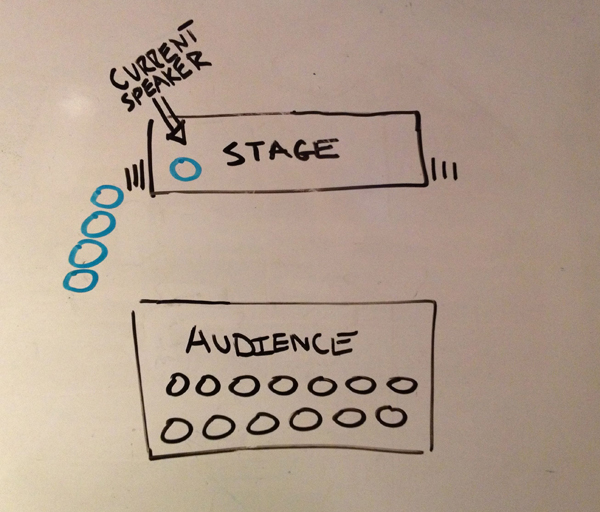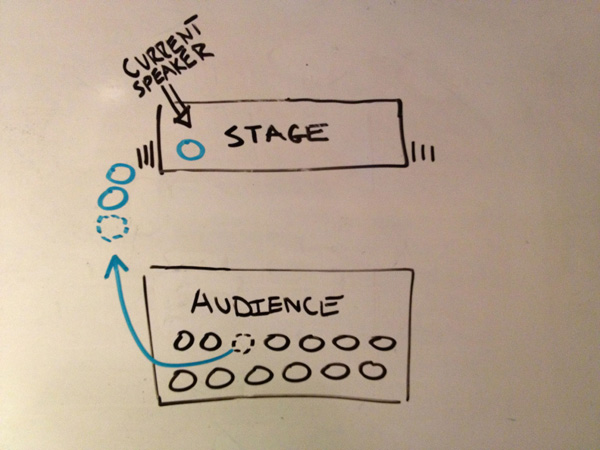99 second presentations
A running joke in the world of presentations is: how short can they be? They used to be an hour. Then TED went to 20 minutes, Pecha Kucha to 6, and Ignite to 5. The trend of short presentations has been on the rise for years and one wonders where it will stop.
But then consider TV advertisements: they’re 30 seconds long. The good ones communicate many ideas well in a very short amount of time.
Years ago I ran an event at Microsoft called Design Day. Each year we’d experiment with different formats and one year we tried 99 second presentations. It went well and we did it the next year too. Unlike most speaking events it gives the audience a real chance to participate.

How it works:
- There’s a stage and a microphone
- You hand pick 5 or 6 speakers to be in line by the wall
- The first speaker gets 99 seconds to speak (they can have a single slide if they want)
- When they’re done, they hand the microphone to the next speaker
- Anyone in the audience can get in line: either to speak on a new topic, or to respond to something they heard.
- Speakers can speak more than once
- When you run out of time, or speakers, the session ends

What happens:
Before the session starts, explain how it works. Make sure the audience knows they can get in line and get a turn.
At first everyone is nervous, but paying attention. How does this work? they wonder. The format itself creates drama, which is good. If you choose good speakers to start the line, and invite them to speak about provocative or important topics, soon someone in the audience will stand up. When this happens, everyone starts listening differently, realizing they too can can get in line.
On finding and coaching speakers
It’s a small commitment to get someone to speak for less than 2 minutes. They can practice their material 10 times in half an hour. The surprise of short format speaking is it forces speakers to get to the good stuff. One year we let the hand picked speakers have a single slide if they wanted. This adds to your logistics, but if they want to give the audience a URL or twitter handle, having it on a slide makes this easier.
Speakers who volunteer can and will use less than 99 seconds, since they won’t have prepared. This is good. You’ll be impressed by the different, clever ways people choose to use their time.
Logistics
You need to have:
- A hand held microphone
- A gong or buzzer to cut people off when they hit 99 seconds (you have to be militant about this). A warning sound at 80 seconds is wise.
- 5 or 10 invited speakers to be the first to go and help set the tone you want. Choose good, provocative speakers that will inspire responses. If you want to play it safe, have a large number of people in the original line. If the session is going to be 30 minutes long, plan for 20 minutes of hand picked speakers. Then even if you fail to get volunteers, worst case you’ll just end 10 minutes early.
- Plant a seed in the audience for someone you know will get in line after things start to break the ice.
- A time limit for when the session ends.
- Afterwards write up a blog post listing all the people who spoke and their contact info – helps people follow up and make connections.

Wonderful idea. It does force people to get to the point. Eliminates microphone hoggers and ramblers. And if someone is bad you let the clock run out instead of giving them the hook.
When I worked for EDS, I attended an in-house class on executive presentations. We had to make a 6 minute pitchon an important topic that would motivate the audience to action. It took a lot of time to prep, but the result was tremendous.
99 seconds works wonders. Even people who might be blowhards filter themselves down before they get in line, knowing they have just over a minute.
I like the idea, but it leaves me wondering what good does it do to the listener? If I had been in the audience, I think it would leave me with practically nothing, especially when you’ve a string of presentations, lined up one after the other without a break. I guess that perspective is never discussed in the post. What do you say?
It depends entirely on what the speakers say :)
The two times I’ve done this particular format what happens is a kind of conversation. People respond to what they heard, and then someone responds to something else. Since there is only one microphone and the time is limited, it creates a powerful kind of shared conversation.
Most events focus very heavily on what the scheduled speakers have to say. If you have a community of attendees at an event who are smart, passionate and opinionated, it can be amazing what good things happen if you open the floor to them.
Of course if you have a community of stupid and bored people, opening the floor might not yield much. It depends on who is in your audience.
As a general rule most events are bad. They’re stiff and boring and everyone struggles to fight off sleep. If for one half hour in every event something dynamic and participatory happened I’m convinced the majority of events would benefit.
oh, yes. I agree that on one thing. it depends on the audience.
However, my point was that, the structure of this sort of presentations might not allow that. If you do allow time for Q/A during the presentations, or after finishing with one, then probably yes. Otherwise, no.
I understand what you mean. Q&A generally isn’t done very well. It’s often not much of a loss. But I see your point.
You could of course still do Q&A: 20 minutes of 99 second presentations. Stop. And open the floor for questions of any of the speakers for 10 minutes.
Scientists make presentations of widely varying lengths, from one hour–typical of an invited seminar talk to a university department–to one minute–in what are called “data blitzes”, where each of many speakers gets one minute to explain one data slide. My experience has been that the longest and shortest presentations are the easiest to prepare and deliver, and that the most difficult is a ten minute presentation.
This is because for a one hour presentation, you have plenty of time to elaborate on things, make digressions, take questions, etc, and yet still be able to amply make your main points. For a one minute presentation of a single data slide, you are basically only making five one sentence points: (1) What is the question addressed? (2) Why should anyone give a shit about that question? (3) What experiment did we do to address that question? (4) What was the result of the experiment? (5) What is the impact of that result on our understanding of the question?
For a ten minute presentation, it is enough time that the audience rightfully expects a reasonably sophisticated explanation of what you are talking about, but it is not enough time to manage any accidental digressions or off point remarks.
Scott, the 99-second presentations were some of my favorites at Design Days, both to present and to watch. Creativity and careful prioritization were never more evident. The best presentations don’t attempt to “cover the material”–they attempt to inspire. Someone goes away determine to try something out, to research a topic, to be nicer to developers, to care more about their users, etc.
My contribution was a video montage called “99 Seconds of User Pain,” excerpts from usability tests and field interviews whose sole purpose was to create empathy and maybe just a LITTLE bit of shame… not to clearly elucidate the issues encountered.
Thanks for comment Ted! You brought back some good memories for me.
Likewise!
And I thought I was pushing the envelope at this year’s Design Day successor, UX Day! :) 7 minute presentations accomplished many of the same goals on a per speaker basis, but what I love about the 99 second idea is the tremendous potential for community participation, both to pitch new ideas and information and to respond to it. I’ll have to keep this in mind for next year!
Phillip: The first time you do the event its all about stacking the deck. Make sure you have 5 or 6 good speakers in line, and at least one plant in the audience. Do that right and magic happens.
I stole this idea for my conference years back. You’ll be pleased to know that we’ve since ended every one of our TestBash software testing conferences with 10-20 99 second talks and it has become a real highlight. It has sincerely has helped many new software testers kick start their software testing speaking opportunities. I thought you would like to know :)